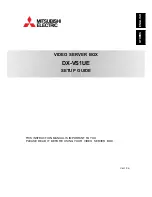
Catalyst® V3 Media Server User Manual
183
Appendix A
Understanding DMX-512
A lighting console typically utilizes a protocol called DMX-512 to communicate with
automated lighting fixtures and conventional dimmers. This protocol consists of 512
unique channels of control per output link (universe). Each channel is capable of
producing 256 values ranging from 0 to 255. Typically a lighting fixture or device will use
a channel for each parameter of the fixture and the associated values of that channel will
control the various functions of that parameter. The lighting console is then programmed
to transmit a corresponding DMX value for the desired function of each parameter. All
DMX values are stored within in the lighting console, and typically are referred to as cues,
scenes, or presets.
Catalyst Media Server Layers operate in the same manner as lighting fixtures in regards
to DMX control. Each parameter of a layer has one or two DMX channels assigned to it,
which when adjusted from a lighting console provides various manipulations of that
parameter. The total range of DMX channels used by a single Catalyst Layer is known as
the DMX protocol and consists of 40 DMX channels.
8-bit vs. 16-bit DMX
Most parameters of an automated light use one channel of DMX providing 256 values of
control (0-255). This is known as 8-bit DMX. Although several parameters of the Catalyst
Media Server use 8-bit DMX, most require a more accurate range of values than can be
provided with a single DMX channel. By utilizing two DMX channels for a single
parameter, 65535 values become available for controlling and adjusting parameter
functions. This is known at 16-bit DMX. You can adjust 16-bit DMX values in both coarse
and fine increments. The first channel of the pair provides coarse control changes of the
DMX value in increments of 256. The second channel of the pair provides fine control and
changes of the DMX value in increments of 1.
Lighting Consoles
Lighting consoles differ in many aspects and it is important to understand how your
console operates with Catalyst Media Servers.
Fixture Libraries.
Many sophisticated lighting consoles utilize pre-made fixture
libraries. A fixture library consists of profiles for various types of lighting fixtures
and devices. Each profile corresponds to the fixture’s DMX protocol and allows
for ease of programming. Depending upon the manufacturer of your lighting
Summary of Contents for CATALYST DV
Page 1: ...MEDIA SERVER User Manual Software Version 3 3 ...
Page 26: ...CHAPTER 2 QuickStart 10 Catalyst V3 Media Server User Manual ...
Page 62: ...CHAPTER 6 Media Playback 46 Catalyst V3 Media Server User Manual ...
Page 70: ...CHAPTER 7 Movement and Size 54 Catalyst V3 Media Server User Manual ...
Page 138: ...CHAPTER 12 Art Net Protocol 122 Catalyst V3 Media Server User Manual ...
Page 150: ...CHAPTER 15 Serial Control 134 Catalyst V3 Media Server User Manual ...
Page 152: ...CHAPTER 16 MIDI Timecode 136 Catalyst V3 Media Server User Manual ...
Page 172: ...CHAPTER 18 Presets 156 Catalyst V3 Media Server User Manual ...
Page 190: ...CHAPTER 20 Diagnostic Displays 174 Catalyst V3 Media Server User Manual ...
Page 198: ...CHAPTER 21 Multiple Servers 182 Catalyst V3 Media Server User Manual ...
Page 208: ...Appendix B DMX Protocol 192 Catalyst V3 Media Server User Manual ...
Page 220: ...Appendix D Product and Safety Information 204 Catalyst V3 Media Server User Manual ...
















































